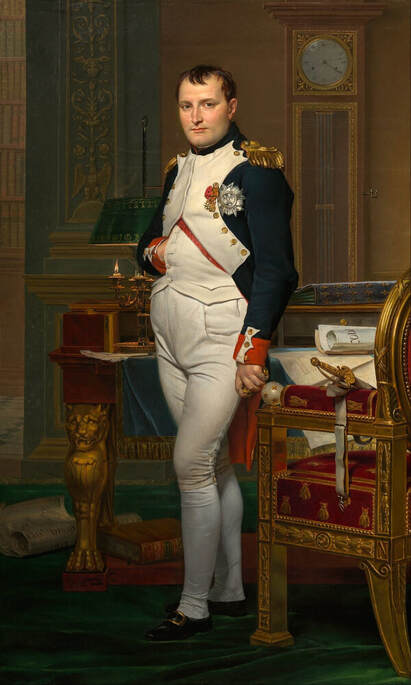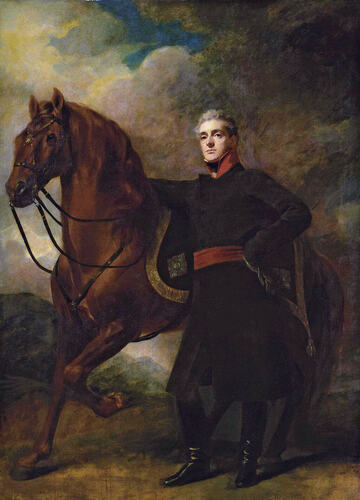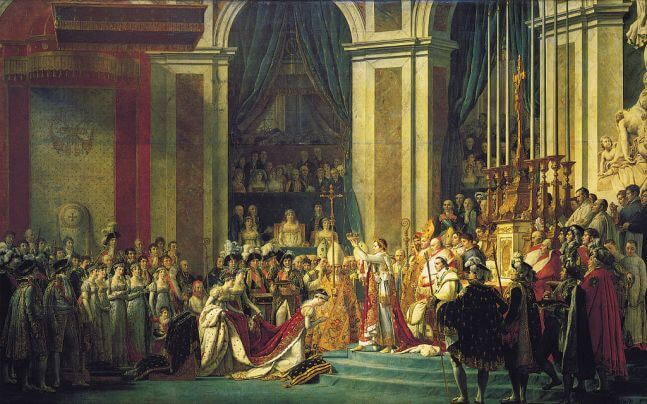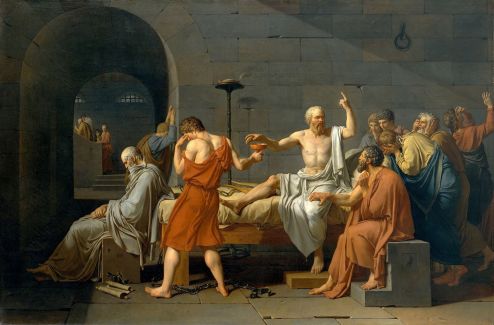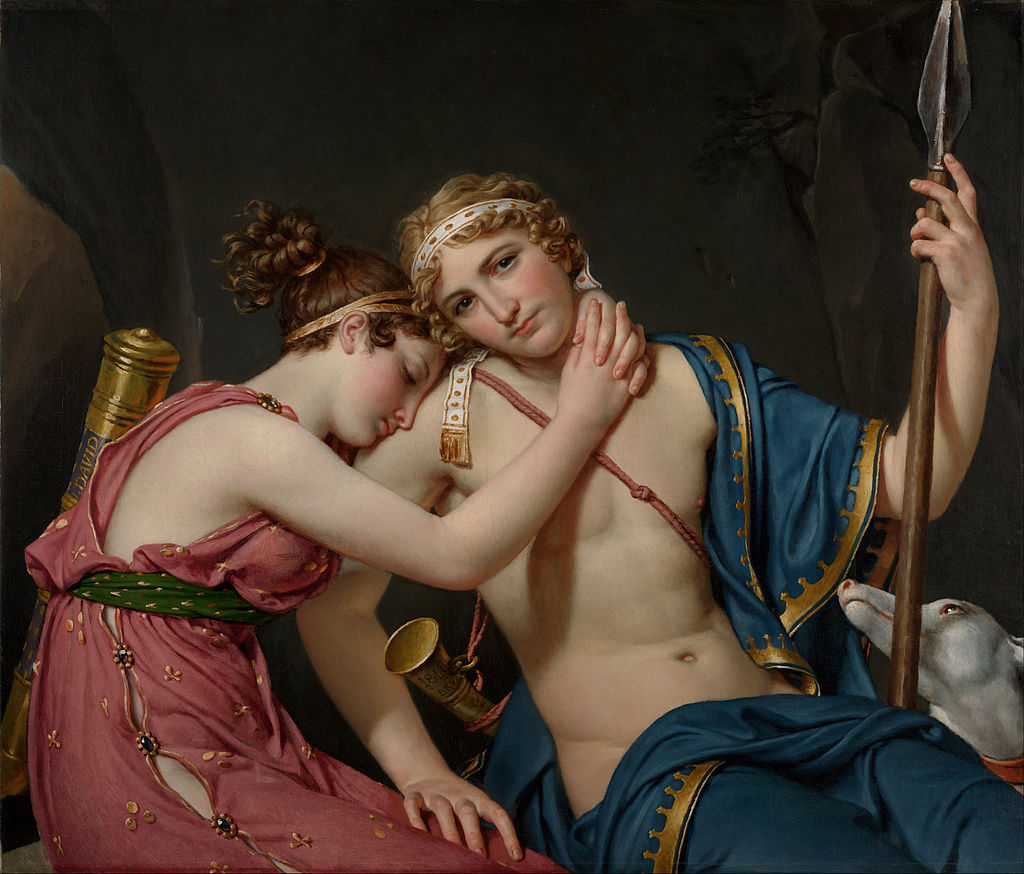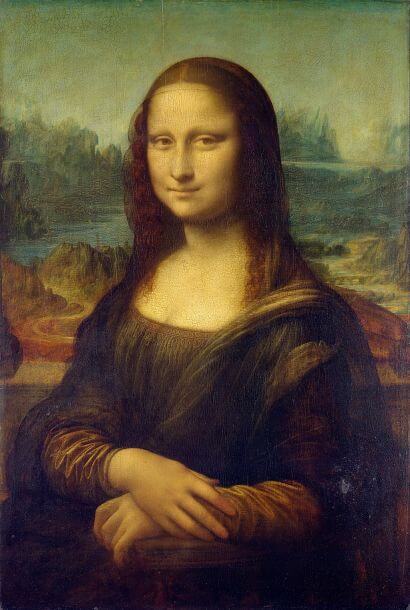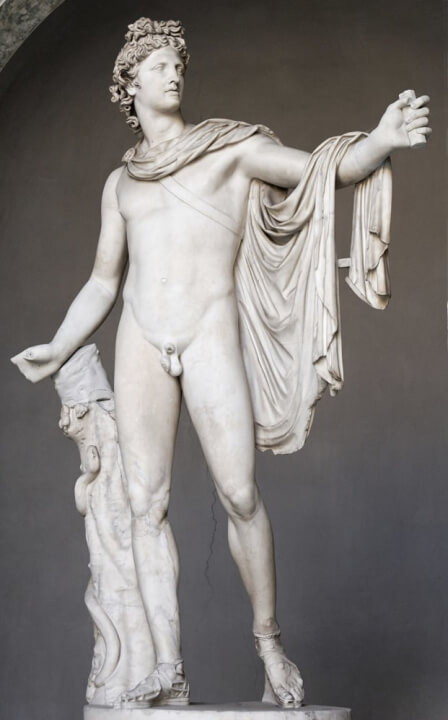|
Where? Gallery 56 of the National Gallery of Art
When? 1812 Commissioned by? Alexander Douglas, the Duke of Hamilton, Scotland What do you see? Napoleon poses in his study in the Tuileries Palace. He has worked all night on the Code Napoléon, which is the civil code full of laws for his empire. His work is illustrated by the quill pen on the left of the desk, the papers laying on the right side of the desk, and the scroll with the letters ‘COD,’ which is the Code Napoléon. He gets up from his work to carry his sword and inspect his troops. Napoleon wears the uniform of the foot grenadiers of the Imperial Guard, a group of elite soldiers in the French army. His uniform consists of the colors of the French flag: blue, white, and red. His uniform is decorated with several military awards (including the legion of honour on the left, the highest French military award), gold buttons, and gold epaulets. He has his right hand in his vest, which is a typical pose for Napoleon, and in his left hand, he holds a so-called snuffbox filled with tobacco. Jacques-Louis David included quite some details in this painting that help to tell a story about Napoleon.
Backstory: In 1811, Alexander Hamilton (1767-1852), the Marquis of Hamilton, contacted Jacques-Louis David to paint a portrait of Napoleon. The Duke admired Napoleon for his power and asked David to “transfer onto the canvas the features of the Great Man, and represent him in one of the historic moments that have made him immortal.” For the rest, David was free to decide on the content of the painting, and he could even decide himself on the price that the Duke would have to pay for it. David happily accepted the commission as it was a recognition of his fame outside France, he did not have any major commissions from the French government, and he could earn a lot of money with it. The painting is since 1961 in the National Gallery of Art.
Symbolism: Jacques-Louis David wanted to portray Napoleon as a correct and truthful man. He also wanted to indicate that Napoleon worked very hard for his empire. He purposely included a clock with the time of 4.13am and a candle that was almost finished to indicate that Napoleon was still working deep into the night.
To further emphasize the hard work of Napoleon, David paints him with unkempt hair, wrinkled stockings wrinkled, and the cuffs of his uniform are not all buttoned. Also, the snuffbox in his right hand shows that he used the tobacco to stay awake. The military decorations and the sword on the chair indicate his success as a military leader. The golden bees on the chair on the left symbolize the diligence of Napoleon. Who is Napoleon? Napoléon Bonaparte (1769-1825) was a military political leader in France. He was the leader of the French Revolution in 1789 and became the Emperor of France in 1804. For the next decade, he was the most important statesman in Europe as the French Empire spanned across a large part of Europe, including countries like Italy, Belgium, and The Netherlands. Who is David? Jacques-Louis David (1748-1825) was born in Paris and died in Brussels, Belgium. He is considered the most important Neoclassical painter. David was an admirer of Napoleon and Napoleon was also a big fan of the work of David. In 1804, David became the official court painter of the French empire. He painted multiple works of Napoleon, including the famous The Coronation of Napoleon in the Louvre. Due to his focus on neoclassicism, he also painted a large number of paintings with classical themes, such as The Death of Socrates (1787) in the Metropolitan Museum of Art and The Farewell of Telemachus and Eucharis (1818) in the Getty Museum.
What is the Tuileries Palace? A palace in Paris that was used by many French monarchs until it burned down in 1871. It was built in 1564 and was an enormous palace in the middle of Paris, next to the Louvre.
Fun fact: Napoleon liked art. For example, the Mona Lisa by Leonardo da Vinci hung in his bedroom. He ordered his troops to bring a lot of famous artworks from throughout Europe to France, including the Apollo Belvedere and The Entombment of Christ by Caravaggio in the Vatican Museums, and The Wedding at Cana by Paolo Veronese in the Louvre. He was also a commissioner and collector of contemporary art, though often to promote himself or his empire. Some of the paintings by David, such as the Coronation of Napoleon, are a good example of this self-promotion. Interested in a copy for yourself? Poster.
Written by Eelco Kappe
References:
2 Comments
|
Categories
All
|
- Home
- Blog
-
Museums
- Alte Pinakothek
- Art Institute of Chicago
- Baltimore Museum of Art
- Barber Institute of Fine Arts
- Bargello
- Barnes Foundation
- British Museum
- Church of Sant’Anastasia
- Cleveland Museum of Art
- Courtauld Institute of Art
- Detroit Institute of Arts
- Frans Hals Museum
- Galleria Borghese
- Gallerie dell'Accademia
- Getty Museum
- Guggenheim
- Hermitage Museum
- Kunsthistorisches Museum
- Kunstmuseum Basel
- Legion of Honor Museum
- Louvre
- Mauritshuis
- Metropolitan Museum of Art
- Musee d’Orsay
- Museum of Fine Arts in Boston
- Museum of Modern Art
- National Gallery in London
- National Gallery of Art
- National Museum in Poznań
- Norton Simon Museum
- Ny Carlsberg Glyptotek
- Palace of Versailles
- Palazzo Pitti
- Palazzo Vecchio
- Petit Palais
- Philadelphia Museum of Art
- Prado
- Pushkin Museum
- Ravenna Art Museum
- Rijksmuseum
- San Diego Museum of Art
- Santa Maria delle Grazie
- St. Peter's Basilica
- Städel Museum
- Statens Museum for Kunst
- Tate Britain
- Tate Modern
- Timken Museum of Art
- Uffizi
- Vatican Museums
- Wallace Collection
-
Artists
- Altdorfer
- Anguissola
- Berlin Painter
- Bosch
- Botticelli
- Boucher
- Bronzino
- Bruegel the Elder
- Brunelleschi
- Cabanel
- Caillebotte
- Canova
- Caravaggio
- Carpeaux
- Cezanne
- Cimabue
- David
- Degas
- Delacroix
- De Maria
- Donatello
- El Greco
- Fontana
- Fra Angelico
- Fragonard
- Gauguin
- Gentileschi
- Gericault
- Gonzalez-Torres
- Goya
- Hals
- Hogarth
- Hokusai
- Ingres
- Leonardo da Vinci
- Lippi, Filippo
- Longhi, Barbara
- Lorrain
- Makovsky
- Manet
- Massys
- Matisse
- Merian
- Michelangelo
- Mochi
- Modigliani
- Monet
- Panini
- Parmigianino
- Perugino
- Picasso
- Pisanello
- Raphael
- Rembrandt
- Renoir
- Reynolds
- Rivera
- Rodin
- Rubens
- Scultori
- Seurat
- Steen
- Tintoretto
- Titian
- Toulouse-Lautrec
- Turner
- Uccello
- Van der Weyden
- Van Dyck
- Van Eyck
- Van Gogh
- Van Hemessen
- Vasari
- Velazquez
- Vermeer
- Veronese
- Vigée Le Brun
-
Locations
- Books
- About Us

